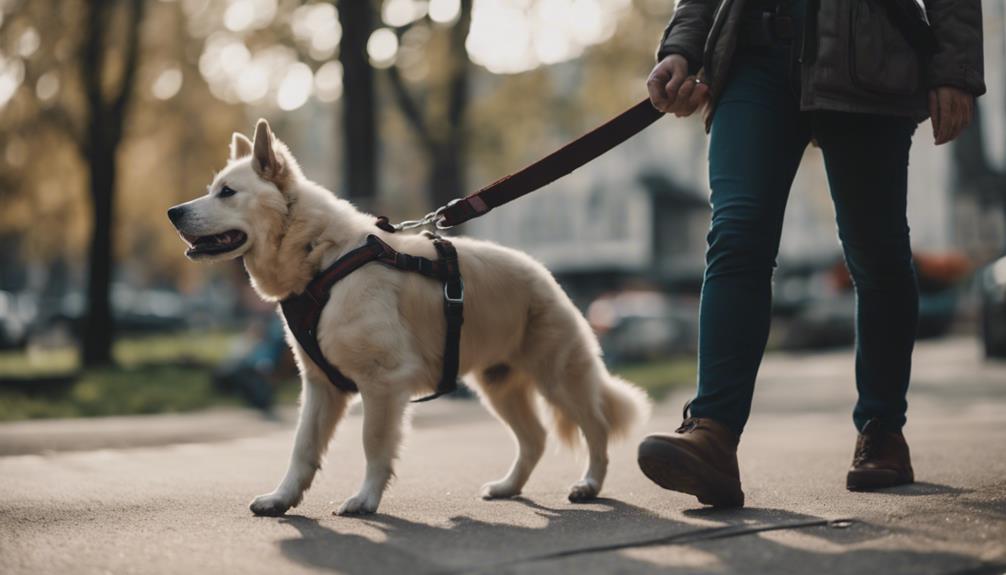The complexity of a collapsed trachea in dogs unveils a multifaceted landscape of triggers and management strategies that demand attention. From genetic underpinnings to environmental influences, understanding the nuances of this respiratory ailment is paramount for effective intervention.
While the clinical signs may seem straightforward, the treatment avenues, ranging from conservative measures to invasive procedures, pose a challenge in navigating the best course of action.
Stay tuned to unravel the intricate web of causes, symptoms, and therapeutic approaches that govern the realm of collapsed trachea in dogs.
Key Takeaways
- Tracheal collapse in dogs results from weakened airways, causing coughing and breathing difficulties.
- Diagnosis involves X-rays to confirm tracheal collapse, with treatment options ranging from medication to surgery.
- Small breeds like Chihuahuas are prone to tracheal collapse, emphasizing the importance of weight management.
- Lifestyle adjustments, like using body harnesses and maintaining a stress-free environment, can aid in managing respiratory issues.
Tracheal Collapse in Dogs: Overview
Tracheal collapse in dogs, a common respiratory condition primarily affecting small breeds, involves the weakening and flattening of the tracheal cartilage, leading to a narrowed airway. This condition results in symptoms such as a dry cough, wheezing, coughing during exercise, and breathing difficulties. Tracheal collapse is known to be chronic, progressive, and potentially life-threatening if left untreated.
Veterinarians typically diagnose this condition using X-rays to confirm the collapse of the trachea. Treatment options include medication like cough suppressants, steroids, and even surgery for severe cases where the trachea needs support to remain open.
Weight management plays a crucial role in preventing tracheal collapse, emphasizing the importance of maintaining a healthy lifestyle for affected dogs, especially those belonging to susceptible breeds.
Genetic Factors and Tracheal Collapse
Genetic factors play a significant role in the development of tracheal collapse in dogs, particularly in small breeds prone to respiratory issues. Certain genetic predispositions can make some dogs more susceptible to this condition, emphasizing the importance of understanding these factors in managing tracheal collapse effectively.
- Breeds Prone to Tracheal Collapse: Small breeds such as Chihuahuas, Pomeranians, and Yorkshire Terriers are at higher risk.
- Inheritance Patterns: Genetic mutations can be passed down from parents to offspring, increasing the likelihood of tracheal collapse.
- Selective Breeding Impact: Breeding practices can either perpetuate or reduce the prevalence of genetic factors related to tracheal collapse.
- Genetic Testing: Utilizing genetic testing can help identify predispositions and guide breeding decisions to mitigate the risk of tracheal collapse.
Age and Tracheal Collapse Connection

With advancing age, dogs may experience an increased susceptibility to tracheal collapse due to physiological changes in their respiratory system. As dogs grow older, the cartilage in their trachea may weaken and lose its ability to maintain the structure of the airway, leading to a higher likelihood of collapse.
The gradual degeneration of the tracheal tissues over time can make older dogs more prone to this condition compared to younger dogs. Additionally, age-related factors such as decreased elasticity and resilience in the tracheal cartilage can contribute to the development of tracheal collapse in senior dogs.
Therefore, owners of older dogs should be vigilant for signs of respiratory distress and seek prompt veterinary care if any symptoms of tracheal collapse are observed.
Environmental Influences on Tracheal Collapse
Environmental factors such as air pollution and exposure to secondhand smoke can contribute to the development or exacerbation of tracheal collapse in dogs. These influences can significantly impact a dog's respiratory health and worsen existing conditions.
To better understand how environmental factors play a role in tracheal collapse, consider the following:
- Air Quality: Poor air quality can irritate the airways, leading to increased inflammation.
- Secondhand Smoke: Exposure to smoke can weaken the tracheal cartilage over time.
- Allergens: Environmental allergens can trigger respiratory distress in dogs with tracheal collapse.
- Chemical Irritants: Harsh chemicals in cleaning products or aerosols can aggravate respiratory issues in susceptible dogs.
Identifying Symptoms of Tracheal Collapse

Exposure to environmental factors such as air pollution and secondhand smoke can significantly impact a dog's respiratory health, leading to the development or exacerbation of tracheal collapse, making it crucial to recognize the symptoms associated with this condition.
Dogs with tracheal collapse may exhibit signs such as a persistent dry cough, wheezing, coughing that worsens during exercise or excitement, and difficulty breathing. The cough is often described as a honking sound and can be triggered by pressure on the trachea, such as from a collar. Additionally, affected dogs may show signs of respiratory distress, such as rapid breathing or noisy breathing.
Identifying these symptoms promptly is essential for timely diagnosis and appropriate management of tracheal collapse in dogs.
Severity Levels of Tracheal Collapse
The severity of tracheal collapse in dogs can vary significantly based on the progression and extent of the airway narrowing. Understanding the different levels of severity can help in determining the appropriate treatment approach.
- Mild Cases:
- Occasional coughing fits.
- Mild exercise intolerance.
- Moderate Cases:
- Frequent coughing episodes.
- Increased breathing difficulties during activities.
- Severe Cases:
- Persistent coughing, often triggered by excitement.
- Significant respiratory distress even at rest.
- Life-Threatening Cases:
- Continuous severe coughing.
- Extreme breathing difficulties, possibly leading to cyanosis.
Confirming Tracheal Collapse: Diagnostic Methods

To accurately diagnose tracheal collapse in dogs, veterinarians employ various diagnostic methods to confirm the condition definitively. X-rays are commonly used to visualize the trachea and assess its structural integrity. Additionally, tracheoscopy, a procedure using a small camera inserted into the trachea, provides direct visualization of the collapsed airway, aiding in the diagnosis.
Fluoroscopy, which involves real-time x-ray imaging, can also be utilized to observe the tracheal collapse during breathing. These diagnostic methods allow veterinarians to assess the extent and severity of the collapse, guiding them in determining the most appropriate treatment plan for the affected dog.
Medication for Tracheal Collapse Treatment
Confirming a diagnosis of tracheal collapse in dogs is crucial for determining the most effective medication for treatment. Medication plays a significant role in managing tracheal collapse, with various options available to alleviate symptoms and improve the quality of life for affected dogs.
Some common medications used in the treatment of tracheal collapse include:
- Cough suppressants: Help in reducing the frequency and intensity of coughing episodes.
- Sedatives: Aid in calming the dog and reducing anxiety, which can exacerbate symptoms.
- Steroids: Decrease inflammation in the airways, providing relief from respiratory distress.
- Antibiotics: Treat or prevent secondary respiratory infections that may arise due to the weakened trachea.
Surgical Interventions for Tracheal Collapse

What surgical interventions are available for managing tracheal collapse in dogs? Surgical options are essential for severe cases of tracheal collapse in dogs. Below is a summary of the common surgical interventions used to manage this condition:
| Surgical Procedure | Description | Success Rate | Recovery Time |
|---|---|---|---|
| Tracheal Stenting | Placement of a stent to support the collapsed trachea | High | Short |
| Extraluminal Ring Placement | Placement of rigid rings around the trachea to keep it open | Moderate | Moderate |
| Tracheal Resection | Removal of the collapsed part of the trachea | High | Longer |
These surgical interventions aim to improve the airflow in the trachea, alleviate symptoms, and enhance the quality of life for dogs with tracheal collapse.
Minimally Invasive Treatment Options
One effective approach for managing tracheal collapse in dogs involves utilizing minimally invasive treatment options. These options aim to provide relief and improve the quality of life for dogs suffering from this condition.
- Bronchoscopic Stent Placement: A stent is inserted into the collapsed trachea to help keep it open.
- Tracheal Stenting: Involves placing a stent to support the weakened tracheal walls.
- Endoscopic Laser Ablation: Uses laser energy to remove excess tissue in the airway, improving airflow.
- Tracheal Stent Placement: Involves placing a stent inside the trachea to maintain its shape and function.
These minimally invasive procedures can offer effective solutions with reduced recovery times compared to traditional surgical interventions.
Lifestyle Adjustments for Tracheal Collapse

To enhance the quality of life for dogs with tracheal collapse, implementing lifestyle adjustments can significantly contribute to managing this condition effectively. These adjustments focus on reducing stress on the airway and promoting a healthier environment for the affected dog. Here are some key lifestyle adjustments for tracheal collapse:
| Lifestyle Adjustment | Description |
|---|---|
| Use of Body Harness | Minimize pressure on the neck and trachea during walks. |
| Maintain a Stress-Free Environment | Reduce anxiety and excitement levels to prevent triggering coughing episodes. |
| Avoid Irritants | Keep the environment free from smoke, strong odors, and other airway irritants. |
| Optimal Weight Management | Prevent obesity to reduce strain on the respiratory system. |
Preventive Measures for Tracheal Collapse
Implementing preventive measures is crucial in reducing the risk of tracheal collapse in dogs, particularly in breeds prone to this condition. To help safeguard your canine companion, consider the following preventive measures:
- Maintain a Healthy Weight: Obesity can exacerbate tracheal collapse.
- Use a Harness Instead of a Collar: Minimize pressure on the trachea during walks.
- Avoid Irritants: Keep your dog away from smoke, dust, and other airway irritants.
- Regular Veterinary Check-ups: Early detection and management can help prevent worsening of tracheal issues.
Conclusion
In conclusion, collapsed trachea in dogs is a serious respiratory condition that can be caused by genetic factors, aging, and environmental influences. Recognizing the symptoms, such as dry coughing and wheezing, is crucial for prompt diagnosis and treatment.
Surgical interventions and medication can help manage severe cases, while lifestyle adjustments and preventive measures play a key role in safeguarding dogs' respiratory health. By understanding the causes, signs, and treatment options for tracheal collapse, pet owners can better care for their furry companions.




